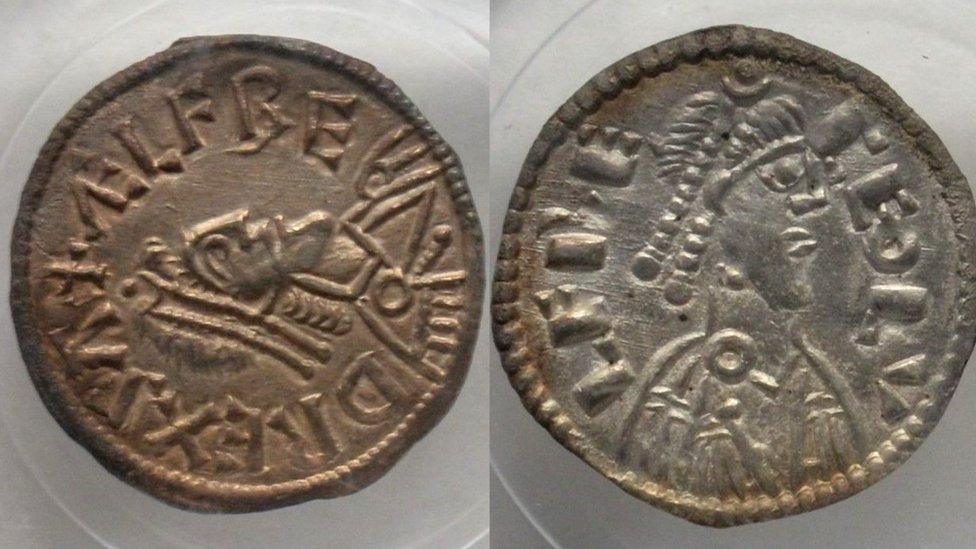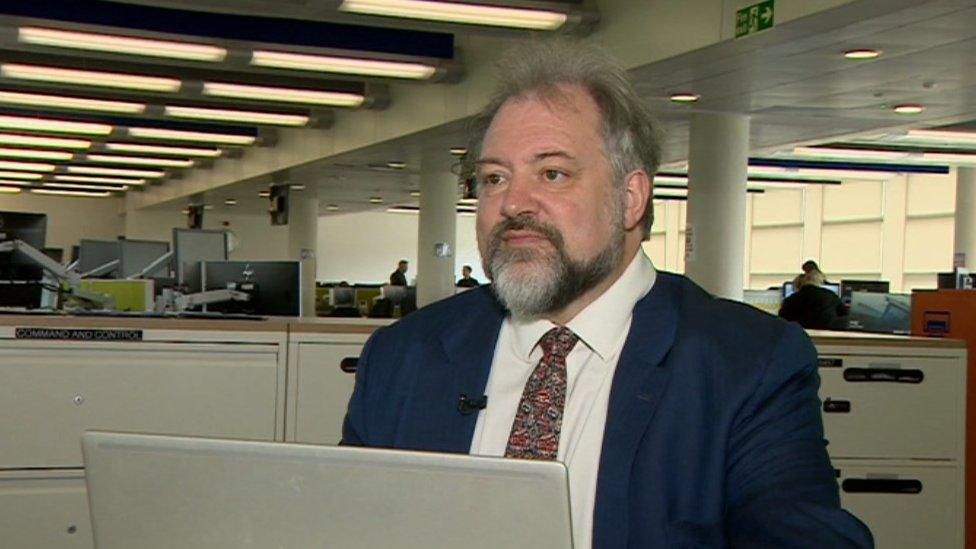Anglo-Saxon coins: Illegally held hoard rewrites English history
- Published

The coins give new information on historical figures
The recovery of 44 Anglo-Saxon coins that were hawked on the international black market has helped reshape historians' understanding of English history.
As two men are convicted of conspiring to sell criminal property, BBC News examines the tangled tale that begins back in the 9th Century.
Collectors Craig Best and Roger Pilling thought they were on to a winner.
They had in their possession dozens of silver coins, some of which they knew were extremely rare. They also knew the coins were part of an undeclared Viking hoard, discovered in 2015, and therefore illegal to own.
Best hawked what he called "big money" coins to potentially interested parties but so rare were some of the items he was trying to peddle that suspicions grew.
Those suspicions eventually led to the involvement of the police.
The conviction of Best, 46, and 75-year-old Pilling is just the latest chapter in a tale that began somewhere in the AD 870s.
Alfred the Great, ruler of Wessex, was leading the Anglo-Saxon resistance against Viking invaders in the struggle that would eventually lead to the creation of a unified Kingdom of England.
The history pages speak of a contemporary, the lesser known Ceolwulf II, King of Mercia.
He has been painted as a somewhat insignificant player, a Viking "puppet" ruler, a minor nobleman held in power by the intruding army.
Ceolwulf is described in unflattering terms in Saxon records, then vanishes altogether, with no clue as to what became of him.
All we know is that Alfred the Great withstood conquest and eventually became ruler of a large part of Ceolwulf's kingdom.
But what if this long-established narrative, penned by Alfred's court chroniclers, is incorrect - or merely part of the story?
This is where two men with metal detectors come in to play...

Craig Best was carrying these three rare coins when police arrested him in a hotel in Durham
Fast forward to 2015, George Powell and Layton Davies uncover a long-lost stash of 300 coins in a field in Eye, near Leominster, Herefordshire.
Had they declared the find and handed it over to the Crown, as required by law, the men are likely to have made a lot of money.
One expert claims finders of such hauls could become "millionaires with no criminal record" if they abide by the rules.
Instead, Powell and Davies concealed their find in the hope of maximising their gains and they were eventually jailed in 2019.
The coins were almost certainly buried by a Viking, but the majority of the £3m hoard remained missing. Just 29 coins were recovered.
Four years later, Durham Police arrested two men in an undercover sting following a "lengthy and complex investigation".
Best, of Bishop Auckland, was arrested in a hotel in Durham while Pilling, of Loveclough, Lancashire, was arrested in his home.
Between them they had 44 of the coins, since valued at £766,000.
In 2018, Best had made contact with US-based coin collector Prof Ronald Bude and had tried to interest him in buying some, including an "Alfred penny".
Unsure of the coins' legitimacy, Prof Bude asked Best where they came from.
In an email Best replied, "near Worcester". Worcester is about 30 miles from the scene of the 2015 find.
Word spread about the availability of extremely rare coins, the authorities were contacted and the undercover operation was mounted.
Among the dozens of coins recovered by the police were two extremely rare examples of two-headed coins bearing images of both Alfred and Ceolwulf.
But why would these two be sharing two sides of the same coin?
Back to the late 9th Century....

Dr Gareth Williams said black market sales of treasure were frustrating to experts
According to experts, the coins suggest that the two kings were much more closely aligned than historians had been led to believe.
Their existence sheds new light on Alfred's reign and transforms our understanding of the allegiances of power during that period.
Two sets of coins featuring both rulers shows they had a "prolonged alliance", according to Dr Gareth Williams, curator of Early Medieval Coins and Viking Collections at the British Museum.
"The coins show beyond any possible doubt that there was a political and economic alliance between Alfred and Ceolwulf II," he said.
"Together the two kings carried out a major reform of the coinage, introducing high-quality silver coins, with the 'two emperors' design symbolising this alliance, followed by a second joint coinage.
"As more coins emerge, it is clear that this monetary alliance lasted for some years.
"The alliance was airbrushed out of history."
The ground-breaking coins are now permanently held at the British Museum where work will continue to unearth more details about the previously unknown relationship between the two kings.
And with the majority of the Viking hoard from 2015 yet to be recovered, who knows what other secrets from history are still out there.

Follow BBC North East & Cumbria on Twitter, external, Facebook, external and Instagram, external. Send your story ideas to northeastandcumbria@bbc.co.uk, external.